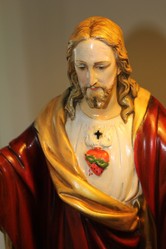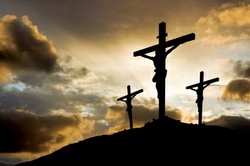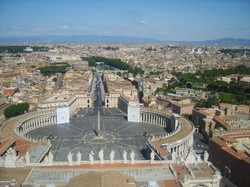That there seems to be a chemical difference in the soils between Nazareth and Sepphoris, roughly half way between the towns indicates that at the time when Sepphoris was operating there was a village at Nazareth whose territory Sepphoris had to respect.The village of Nazareth was once thought to have been quite tiny, having no more than 100 people, but modern discoveries reveal a town of about a thousand. Sepphoris, having been destroyed in the first century BC, was rebuilt in 4 BC. This recognition of Nazareth's boundaries shows that Nazareth was in existence when Sepphoris was rebuilt, a fact that rebuts certain specious claims that Nazareth was only built after the year AD 70.Such claims as these reflect the poor quality thinking that goes into much religious,or should I say quasi-religious discussion. Some of this stuff is merely anti- Christian polemic.
The village in which Jesus dwelt contained stone houses some of which had caves hewn into the hill on which the town was situated. Why these caves were carved out remains unclear. Some have suggested that they were defence against Romans, but this seems unlikely, as such caves would be effectively a trap or a prison for those who went into them. It seems most likely to me that they were cool storage places for perishable goods or safe places to secure valuables. They might have therefore been cellars.
What of the people of Nazareth. They seem to have been predominantly traditional Jews of strict observance,but to which branch of Judaism they belonged we cannot say for sure. Judaism had a plethora of sects at the time, of which but a few survived the turmoil of the revolt of AD 70. It seems unlikely that they were Sadducees, as they were mainly drawn from the high priestly class and were based near Jerusalem. Zealots, who practised anti-Roman terrorism do not seem to feature in descriptions of Nazareth and are hardly mentioned in the gospels. I suspect that they had sympathies with either the Pharisees or the Essenes. Both of these groups were of strict observance, but only the Pharisees survived to become the basis of orthodox Judaism, while the Essenes simply disappear from history. They were a group of the strictest religious observance possibly connected with the community who owned the Dead Sea Scrolls. My view is that Pharisaism was influential at Nazareth, but that the Essene movement may have had some followers there.
Interestingly, while Jesus often criticizes the Pharisees and Sadduces, he never has a critical word to say about the Essenes, or at least none is recorded. Why this is so we know not.
Nazareth is now a predominantly Arab town with a Palestinian population. It contains a basilica [large church] dedicated to the annunciation, the event in which Jesus was conceived by Mary when the angel Gabriel revealed God's will to her. It is an important Christian pilgrimage site.




 Pilgrimage. A reviewon 06/15/2025
Pilgrimage. A reviewon 06/15/2025
 Leo the Fourteenthon 05/09/2025
Leo the Fourteenthon 05/09/2025
 The Melsonby Hoardon 03/25/2025
The Melsonby Hoardon 03/25/2025


Comments
There were certain dominant languages in the Middle East, i.e. Greek, Aramaic, Arabic, Persian, and possibly Coptic. Latin was only an official language.
Thank you for your comment below in answer to my previous observation and question.
Ancient peoples and their monolingualism or multilingualism intrigue me.
What language might have mattered to ancient Romans and Middle-East populations? Might they have resorted to a local language or Greek or Hebrew or Latin?
ThebRomans had as little to do with the Essenes as possible, and the Essenes felt the same way
Thank you for your comment below in answer to my previous observation and question.
Online sources associate the Essene community with Aramaic, Greek and Hebrew. Other sources broach Aramaic, Greek, Hebrew and Latin with the Essene community.
Did the Romans communicate in Aramaic, Greek, Hebrew or Latin with the Essene community?
The Essenes were buried at Quran, but at the end the Romans would have left Essence bodies to rot.
The computer crashed before I communicated another concern within the comment below.
Some online sources associate the Qumran archaeological site and the Qumran caves with the Essene community. English Wikipedia considers a Qumran cemetery with perhaps 1,000 bodies of mostly men.
Is the Essene community buried there?
Thank you for your comment below in answer to my previous observation and question.
That they approached their deaths without arranging property transfers (to assure their memory) is something that I feared.
Might the Essenes have had little or substantial property that motivated jealous antagonism either because it was a case of little or much property of great value?
The Essenes were massacred and son had little or no time to dispose of property.
Thank you for your comment below in answer to my previous observation and question.
So the events of A.D. 70 and 73 communicate the physical deaths of all Essenes.
Did the Essene community dispose of their non-religious and religious property?
No. The sect did not survive the troubles of the rebellion of AD 70